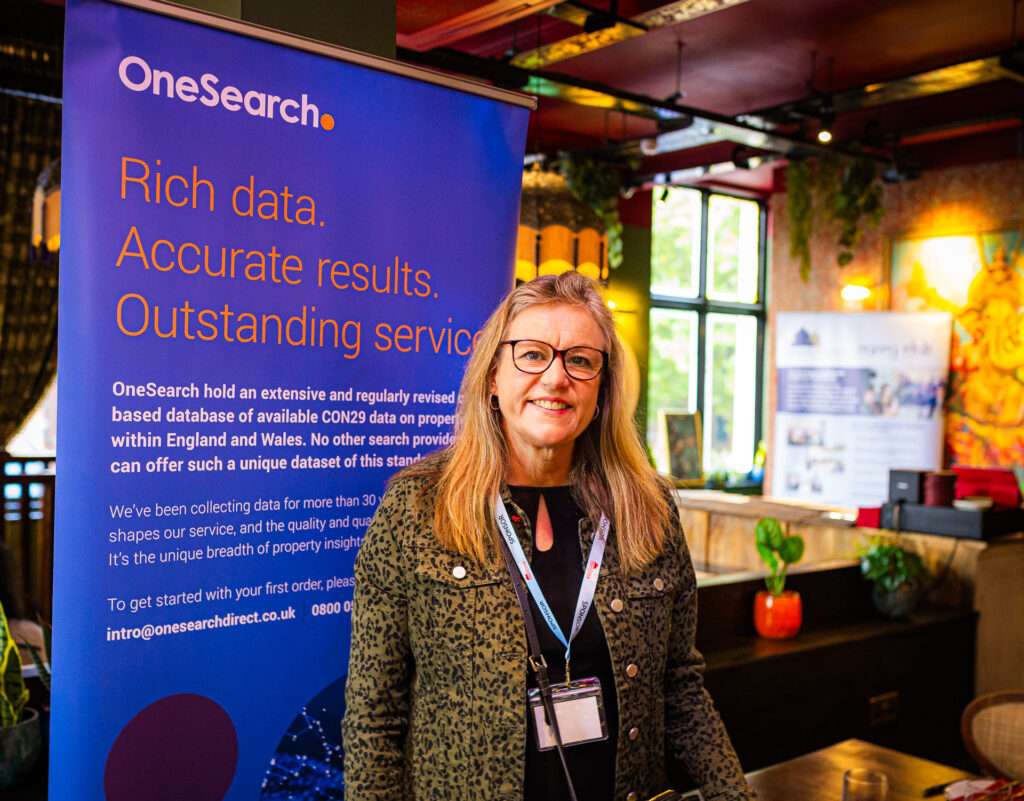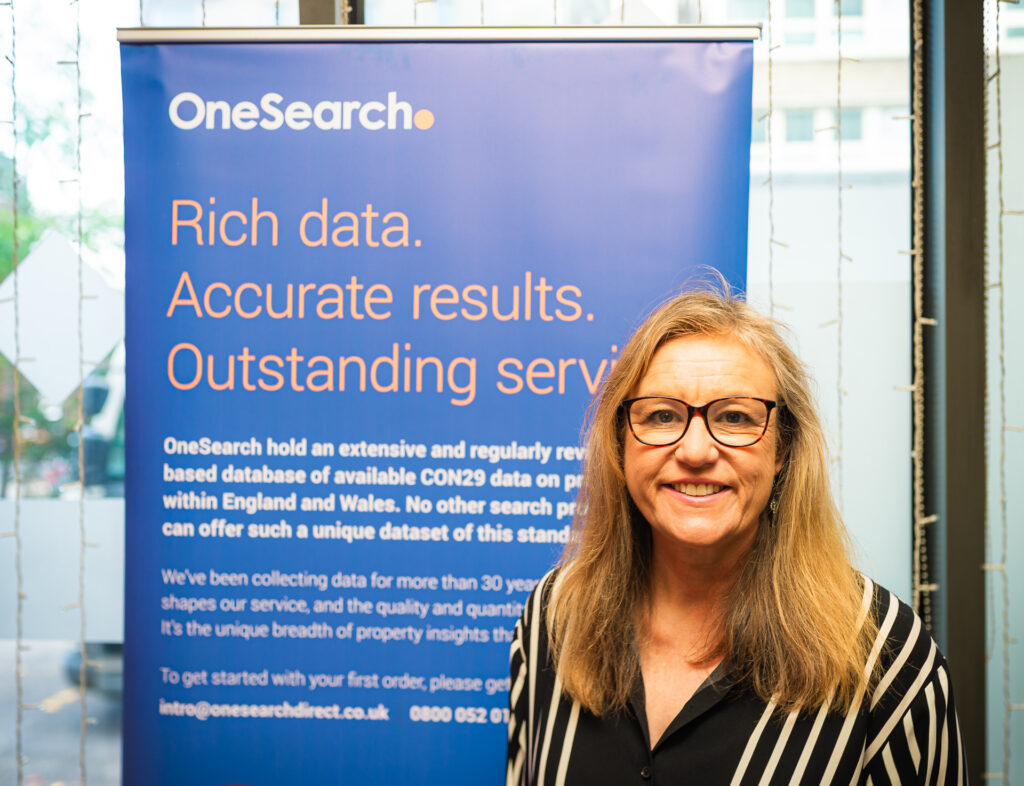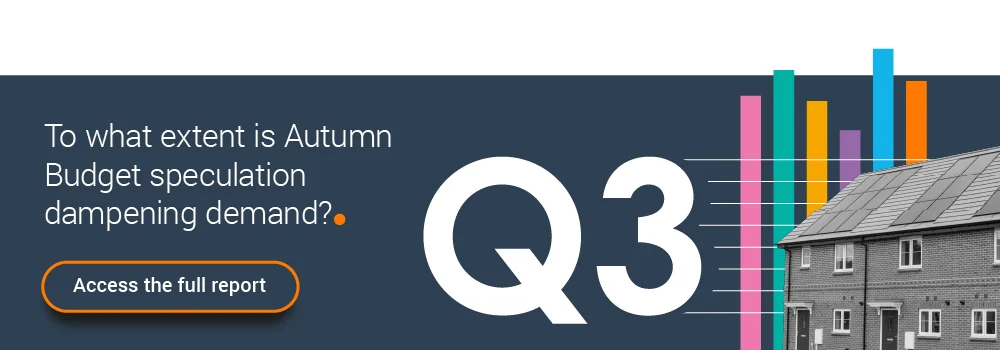2025 has been a year of meaningful networking and collaboration, and there’s nowhere more engaged in networking than the Midlands.
Through our partnership with networking group, PropertyFace2Face (PF2F), OneSearch proudly sponsored and co-hosted five vibrant Curry Club lunch events that brought property and construction professionals together in Leicester, Nottingham, and Derby. These gatherings weren’t just about exchanging business cards – they were about building relationships, sharing ideas, and creating opportunities.
Celebrating Five Fantastic Events
This year, we joined forces with PF2F for five unique events, each with its own flavour and energy:
- 7 February – Leicester Comedy Curry Club, MemSaab Restaurant
A lively lunch of laughter with professional comedian, Arthur Smith and networking that sets the tone for the year ahead. - 9 May – Derby Curry Club, Nicco Restaurant
A spring meet-up which sparked conversations and new collaborations over a curry. - 21 August – A Slice of Summer Social, Nicco Restaurant
Derby’s property and construction professionals celebrated in the sun, enjoying delicious Indian canapés, Prosecco and live Ibiza-style music in August. - 19 September – Nottingham Curry Club, MemSaab Restaurant
An engaging event with speed networking that brought together like-minded Notts property and construction professionals. - 9 October – High Chai & Chatter, Passan’s Restaurant, Nottingham
The premiere High Chai & Chatter event took place in October, featuring a Nottingham-themed quiz and a delicious Indian-inspired take on Afternoon Tea.










Each event had its own highlights, but all shared one common theme: meaningful connections that create new business opportunities.
Claire Slade, Business Development Manager at OneSearch, said:
“It’s been incredible to see these Curry Club events bring people together. Each one has sparked new conversations and opportunities – and that’s what networking is all about.”
Sasha Stewart, Co-Founder, Property Face2Face added:
“Partnering with OneSearch this year has been a fantastic experience. Together, we’ve created spaces where property and construction professionals can connect, collaborate, and thrive. We can’t wait to continue this journey in 2026.”
Looking Ahead to the New Year
The momentum doesn’t stop here. We’re kicking off the new year with another exciting PF2F event at Mint Leaf Lounge Restaurant, Bank, London on Thursday, 22nd January 2026 – and we’d love to see you there!
👉 https://pf2f.co.uk/event/22nd-january-2026/
Join the Conversation
Follow us on LinkedIn for updates and photos from our events, and join the conversation using #PF2F #OneSearch.
In conveyancing, it only takes one piece of flawed or unverified data to turn a smooth transaction into a costly nightmare.
The real cost of dealing with fragmented search results isn’t just wasted time; it’s the threat of disputes, liabilities, and fall-throughs that erode confidence and damage your firm’s reputation. If you’re tired of spending valuable hours double-checking sources or dealing with last-minute data surprises, you need a method that guarantees accuracy and peace of mind.
To give you a clear, visual understanding of the solution, we’ve created a new infographic: Solving the Data Puzzle. It lays out our meticulous, forensic methodology – the Triple Check – that ensures accuracy across all three key stages of data collection and review. Download it to instantly see why our unparalleled data foundation delivers the clarity, confidence, and efficiency you need to succeed.

As part of the continued roll out of new and remastered reports, our attention has turned to our agricultural offering, the SiteSolutions Farm report.
You might wonder why it’s important to order a SiteSolutions Farm report instead of a traditional environmental search, after all, don’t they cover the same factors? In reality, agricultural transactions involve a host of unique considerations. For example, the Environment Agency has reported that agricultural runoff is the single biggest polluter of rivers, responsible for 40% of waterway damage. This highlights the need for an agricultural report that goes beyond a standard contaminated land liability assessment.
Agricultural considerations
Farm transactions involve a broader range of factors, often making reports more complex and harder to interpret. Our reports are built differently – offering clear analysis and mapping of key agricultural issues such as pollution incidents, poor land management, intensive farming, and land classification, alongside standard assessments of flood and contamination risk. These localised factors, unique to agricultural land, are surfaced and presented as prudent enquiries to help conveyancers identify potential issues early, facilitating a smoother transaction.
Template redesign
The redesigned front page features a clear summary that instantly highlights contamination and flood risks, with direct hyperlinks to the relevant sections within the report. Risk ratings, summary maps, and consultant commentary are now unified on one page, allowing clients to quickly access the same insights as our consultants and build confidence in our conclusions. All data is analysed by a consultant and presented in plain English, free of jargon and acronyms, for clarity and accessibility. Author contact details are also prominently displayed for easy access to expert support.
Professional opinion
At Landmark, we believe that assessments without environmental consultant input fall short. Our reports empower consultants to apply their expertise, rather than simply echoing raw data, which often lacks context. A great example of this is in the flood section, where automated data can exaggerate the nature and extent of risk. Our consultants assess flood risk holistically, considering topography, land type, and existing water features, to provide a more accurate and representative outcomes. Justifications for these assessments are included in the commentary, ensuring transparency. We only report a risk as significant when it truly is.
Considering development?
With the government placing greater emphasis on energy scrutiny and the transition to a low-carbon economy, there’s a growing trend in renewable energy projects. Farm owners are increasingly seeing this as an opportunity to diversify their land, especially in areas that don’t yield strong returns from traditional farming. The good news is that, provided certain parts of the farm remain in agricultural use, the SiteSolutions Farm report can support redevelopment projects such as solar and wind farms.
Summary
Our farm report is tailored to the specific context of agricultural transactions, with bespoke recommendations that highlight potential liabilities and localised risks, from flooding to broader environmental factors unique to farmland. It offers comprehensive oversight for every transaction.
Explore the future of environmental due diligence
Landmark’s redesigned Argyll SiteSolutions reports set a new standard for environmental searches. With an intuitive design, industry-leading data interpretation, and upgrades that address today’s most pressing risks, these reports empower you to deliver exceptional service to your clients.
Discover the full portfolio here: https://hubs.la/Q03NgCTp0
When purchasing a residential property, especially a high-value or complex one, environmental risks are often overlooked until it’s too late. Industry analysis shows that skipping thorough environmental due diligence can lead to costly surprises, legal headaches, and even failed transactions.
Here’s why Landmark’s redesigned Argyll SiteSolutions Residence report could be your smartest investment in peace of mind.
When your clients dream home comes with a hidden legacy
Picture your client purchasing their ideal home, only to later uncover that the land beneath it was once used for industrial purposes, such as a gas works or depot. While not every case makes headlines, this kind of situation is not uncommon. There are numerous examples where homeowners have discovered soil contamination linked to historic land use, triggering a long and complex process to determine who is responsible for the clean-up costs.
One particularly striking case is in Willenhall, where residents endured a decade-long ordeal after discovering their homes were built on a former gas works site that closed in 1957. The properties were developed by McClean and E Fletcher Builders (now dissolved), and in 2007, Walsall Council began investigating the site as part of its contaminated land strategy. They discovered areas contaminated with benzo(a)pyrene, a known carcinogen, alongside heavy metals, tars, and a gasworks by-product called Blue Billy. The contamination posed a significant possibility of harm, and nearly 90 homes near Kemble Close, Oakridge Drive, and Brookthorpe Drive were declared affected.
In 2015, Walsall Council served a remediation notice on Jim 2 Limited, claiming the company was liable for the contamination. The firm appealed to the Planning Inspectorate, leading to a public inquiry. After years of legal wrangling, the local authority was left with a potential £2.5 million remediation bill, and residents were left in limbo, uncertain when or how the remediation would be completed.
Had a SiteSolutions Residence report been commissioned during the purchase process, our environmental consultants would have flagged the site’s industrial history and potential contamination risks through detailed historic land use analysis. This would have empowered buyers to renegotiate, seek further investigation, or walk away before committing.
Flood: the growing threat
Flooding is still too often seen as a concern limited to riverside properties. Today, more than 4.6 million homes across the UK are at risk from surface water flooding, a number that continues to rise.
When selecting an environmental search for a residential property, the SiteSolutions Residence report stands out as the most comprehensive choice. Our consultant-led flood risk assessments take into account the entire site, delivering a more accurate and practical understanding of flood exposure, particularly valuable for larger or more complex properties.
This boundary-based approach helps buyers and conveyancers:
- Identify flood risk across the full extent of the property, including gardens, driveways, and outbuildings.
- Provides advice on how flood risk may affect planned renovations, extensions, or future development.
- Flag potential insurance challenges or premium increases that could impact affordability or mortgage approval.
Understanding future risks
With the release of the Law Society’s Guidance on Climate Change in 2023, followed by the “Climate Change and Property” practice note for solicitors published in May 2025, environmental due diligence is now expected to go beyond present-day risks. As warmer, wetter winters and hotter, drier summers become more common, these shifting weather patterns, along with rising sea levels, are increasing the likelihood of hazards such as flooding, subsidence, coastal erosion, and heat stress.
To help buyers understand how these future scenarios could affect the usability, value, or adaptation needs of a property, our redesigned SiteSolutions Residence report offers the option to include or exclude climate change analysis, at no extra cost. This flexibility allows conveyancers and their clients to tailor the level of insight to suit the needs of each transaction.
This enhanced due diligence helps to:
- Highlight long-term environmental risks that may affect how a property is used or maintained over time.
- Identify areas where adaptation measures are required, such as flood defences or insulation upgrades may be necessary, helping clients plan for future costs.
- Demonstrate a proactive approach to risk management, aligning your advice with best practice and reinforcing your commitment to thorough client care.
By integrating climate change analysis, the SiteSolutions Residence report supports both home buyers and solicitors in navigating an evolving risk landscape, ensuring that your transaction is underpinned by robust, forward-looking due diligence.
Legal liabilities: protecting buyers and solicitors
Lack of environmental due diligence doesn’t just hurt buyers, it can also lead to legal claims against solicitors. Missed risks like contamination or flood zones can result in unexpected remediation costs, mortgage refusals, or even lawsuits. The Law Society recommends comprehensive environmental searches for all property transactions, especially for high-value or older homes. The SiteSolutions Residence report is manually written and reviewed by accredited consultants, providing clear, actionable insights that protect both buyers and legal professionals.
What makes the SiteSolutions Residence report different?
- Manual, consultant-led analysis: every report is written and reviewed by an IEMA-accredited environmental consultant, not just a computer algorithm. This enables enhanced due diligence of environmental risks.
- Bespoke risk assessments: the report evaluates potential contamination risks both on-site and in the surrounding area, helping you understand how historic or nearby contaminative land uses could create legal liabilities or impact future development plans. Our flood risk assessments also highlight any concerns that may affect the current use of the property or any proposed changes, ensuring you and your clients are fully informed before proceeding.
- Boundary-based reporting: the report assesses the actual site boundary, not just a central point, crucial for large or irregular properties.
- Actionable recommendations: bespoke guidance on next steps, so you’re never left guessing.
Don’t let your clients dream home become a nightmare
Whether you’re a buyer, solicitor, or property professional, the Argyll SiteSolutions Residence report is your safeguard against hidden environmental risks. It’s not just about ticking a box, it’s about making informed decisions, protecting your investment, and ensuring peace of mind.
Explore the future of environmental due diligence
Our redesigned Argyll SiteSolutions reports set a new standard for environmental searches. With an intuitive design, industry-leading data interpretation, and upgrades that address today’s most pressing risks, these reports empower you to deliver exceptional service to your clients.
Discover the full portfolio here: https://hubs.ly/Q03NgBtk0
Local Authority Searches are a cornerstone of every property transaction, but not all searches deliver the same level of clarity, consistency, and reliability. Variations in council processes can lead to delays and confusion – something no conveyancer wants when deadlines are looming.
That’s why thousands of professionals across the UK trust OneSearch Prime, our flagship Regulated Local Authority Search. Here’s why OneSearch Prime stands out and how it helps you work smarter.
In a profession where time is money and accuracy is everything, having a dependable search product isn’t just a convenience – it’s a necessity. OneSearch Prime helps you work smarter, reduce risk, and deliver a better experience for your clients.
Join the growing number of conveyancers who are choosing smarter searches. Register with OneSearch today and start ordering OneSearch Prime with confidence.
UK property market enters ‘suspended animation’ amid Autumn Budget speculation
Our Q3 2025 Property Trends Report reveals that the UK housing market entered a period of ‘suspended animation’ during the third quarter of the year, with uncertainty over potential property tax changes in the run-up to the Autumn Budget causing the market to adopt a holding pattern.
Across England and Wales, there was a 1% drop in new property listings year-on-year. Sales agreed (SSTC) were 6% lower than in Q3 2024, while completion and search order volumes tracked in line with 2024 levels. Mortgage valuation numbers held steady, but remortgaging continued to drive much of the market activity.
Other key findings from Q3 2025 include:
- Listings volumes were down 1% vs Q3 ‘24 volumes.
- In Scotland, listings were down 4% in Q3 ‘25 vs Q3 ‘24.
- SSTC volumes in Q3 ‘25 were down 6% compared to Q3 ‘24 volumes.
- SSTM levels in Scotland were up 4% in Q3 ‘25 vs Q3 ‘24.
- Completion volumes were up 1% in Q3 ‘25 compared to Q3 ’24.
- In Scotland, completions were up 10% in Q3 ‘25 vs Q3 ‘24.
Download the report for the latest trends affecting the residential sector in Q3 2025.
